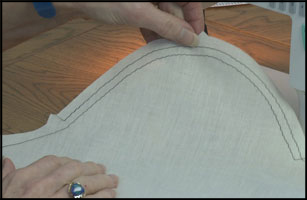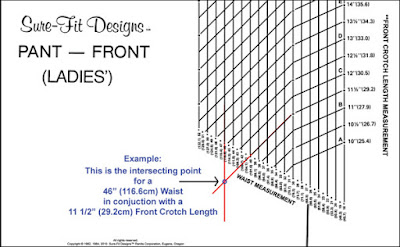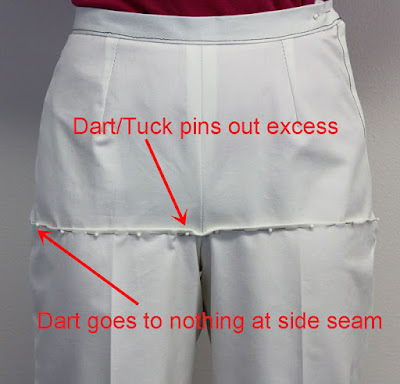As you read in last week's blog - Sleeves and all their Quirkiness - the Sure-Fit Designs Sleeve pattern is designed for ease of use, both in drawing and in construction, meaning the hem level is straight with a 1" (2.5cm) wide fold-up hem. A you increase the forward pitch, the hem will/should change to a gradual curve. Additionally, the front underarm seam will bend to follow the forward hang of your arm.
Directions:
1. Trace a copy of your SFD sleeve
pattern WITHOUT seam allowances or
hem allowance. Label as shown: A - B -
C - D - E - F - G - H. (Point F & I will be
established during the drawing).
2. Extend the grainline down to the hem level, point A.

3. Draw a line from point A to B.
4. Cut from point A to B, and from C to B. Leave a tiny paper hinge at point B - the pivot point.
5. Pivot section A-B-C-D toward the middle of the sleeve. Point D will move 'inward' 1/2" (1.3cm). This is easiest done on a grain/grid board as shown. Tape to secure.
6. Since 1/2" (1.3cm) was taken away from the hem width on the back underarm seam, you need to add this amount 1/2" (1.3cm) to the right of point E on the front underarm seam. Label as point F. This maintains the same wrist circumference opening to pull the sleeve over your hand.
7. Connect point F to G. Point G should be smoothed slightly. Measure both the front and back underarm seam lengths - minus the dart space on the back seam. Underarm seams need to be the same length or a tiny bit shorter in the front (which would be eased into the back seam). Adjust the length of the front underarm seam if necessary.
8. F to G to H is the front underarm seam. You may want to curve/bend this seam further. It will depend on if you have enough elbow circumference ease for your particular arm shape. If you'd like to shape this seam, mark 1/2" (1.3cm) toward the left of point G. Label as point I. Connect F to I to H. Use the Designing Stylus to blend/shape the curve at this bend in the seam. Now that you have substantially changed the length and shape of the front underarm seam, compare to the length of the back underarm seam - minus the dart space. Lengthen or shorten at the hem level as needed.

 wider. Simply back the opening with tracing vellum. Tape securely. Re-establish the center fold line of the dart and the new dart side seam cutting lines.
wider. Simply back the opening with tracing vellum. Tape securely. Re-establish the center fold line of the dart and the new dart side seam cutting lines.
10. At the wrist/hem level, connect point D to F in a slightly curved line. The Designing Stylus is a great tool to draw this transition.
Happy Sewing,
Directions:
1. Trace a copy of your SFD sleeve
pattern WITHOUT seam allowances or
hem allowance. Label as shown: A - B -
C - D - E - F - G - H. (Point F & I will be
established during the drawing).
2. Extend the grainline down to the hem level, point A.

3. Draw a line from point A to B.
4. Cut from point A to B, and from C to B. Leave a tiny paper hinge at point B - the pivot point.
5. Pivot section A-B-C-D toward the middle of the sleeve. Point D will move 'inward' 1/2" (1.3cm). This is easiest done on a grain/grid board as shown. Tape to secure.
6. Since 1/2" (1.3cm) was taken away from the hem width on the back underarm seam, you need to add this amount 1/2" (1.3cm) to the right of point E on the front underarm seam. Label as point F. This maintains the same wrist circumference opening to pull the sleeve over your hand.
7. Connect point F to G. Point G should be smoothed slightly. Measure both the front and back underarm seam lengths - minus the dart space on the back seam. Underarm seams need to be the same length or a tiny bit shorter in the front (which would be eased into the back seam). Adjust the length of the front underarm seam if necessary.
8. F to G to H is the front underarm seam. You may want to curve/bend this seam further. It will depend on if you have enough elbow circumference ease for your particular arm shape. If you'd like to shape this seam, mark 1/2" (1.3cm) toward the left of point G. Label as point I. Connect F to I to H. Use the Designing Stylus to blend/shape the curve at this bend in the seam. Now that you have substantially changed the length and shape of the front underarm seam, compare to the length of the back underarm seam - minus the dart space. Lengthen or shorten at the hem level as needed.

9. The elbow dart has become slightly
 wider. Simply back the opening with tracing vellum. Tape securely. Re-establish the center fold line of the dart and the new dart side seam cutting lines.
wider. Simply back the opening with tracing vellum. Tape securely. Re-establish the center fold line of the dart and the new dart side seam cutting lines.10. At the wrist/hem level, connect point D to F in a slightly curved line. The Designing Stylus is a great tool to draw this transition.
11. Lastly, add 5/8" (1.6cm) seam allowances to all edges. Because the wrist/hem level is now curved, you can't use a fold up hem allowance. This edge will require a shaped facing.
Sew a trial sleeve to test this pattern shape on your arm. Depending on the shape and hang of your arm, you may need to further increase the forward pitch and/or change the shape of the front underarm seam.
Happy Sewing,















































